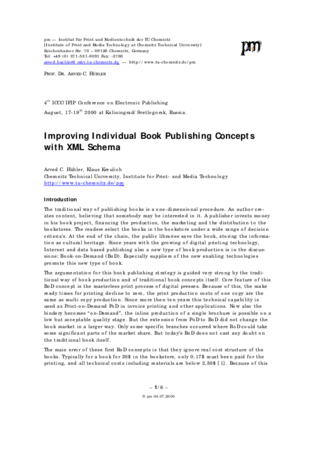The traditional way of publishing books is a one-dimensional procedure. An author creates content, believing that somebody may be interested in it. A publisher in-vests money in his book project, financing the production, the marketing and the distribution to the bookstores. The readers select the books in the bookstore under a wide range of decision criteria’s. At the end of the chain, the public libraries save the book, storing the information as cultural heritage. With the growth of digital printing technology, the Internet and data based publishing, a new type of book production is also in the discussions: Book-on-Demand (BoD). Especially suppliers of the new enabling technologies promote this new type of book. The argumentation for this book publishing strategy is guided very strong by the traditional way of book production and of traditional book concepts itself. Core feature of this BoD concept is the masterless print process of digital presses. Be-cause of this, the make ready times for printing decline to zero, the print production costs of one copy are the same as multi copy production. Since more then ten years this technical capability is used as Print-on-Demand PoD in invoice printing and other applications. Now also the bindery becomes “on-Demand”, the inline production of a single brochure is possible on a low but acceptable quality stage. But the extension from PoD to BoD did not change the book market in a larger way. Only some specific branches occurred where BoD could take some significant parts of the market share. But today’s BoD does not cast any doubt on the tradi-tional book itself. The main error of these first BoD concepts is that they ignore the real cost struc-ture of the books. Typically for a book for 20$ in the bookstore, only 0,17$ must be paid for the printing, and all technical costs including materials are below 2,50$ [1]. Because of this reason, real cost savings in production and logistics are not so high and only in some special applications BoD is attractive. We have to take another important fact into account: There are only a few authors writing books without any commercial interest and with the goal to sell only two or three copies. The success story of a book is, either in non-material or in commer-cial categories, to spread it. From this point of view, BoD is a disaster for the author and the publisher, who can not think about individual books economically. BoD solved only their second problem, the production. But the first problem, how to reach the reader who needs the book, remains. Consistently, today’s BoD is not really successful. We call this concepts “1st stage BoD (1°BoD)”, whereby the books are characterized by new production concepts and new output technologies (PoD, but also E-Books and CD-ROMs), but tradi-tional business models and content handling.
Hübler, Arved, and Klaus Kreulich. "IMPROVING INDIVIDUAL BOOK PUBLISHING CONCEPTS WITH XML SCHEMA." In Electronic Publishing 2000. Electronic Publishing in the Third Millenium: Proceedings of an ICCC/IFIP Conference. ELPUB. Washington D.C.: ICCC Pres, 2000.
Conference held at Kaliningrad/Svetlogorsk, Russia
